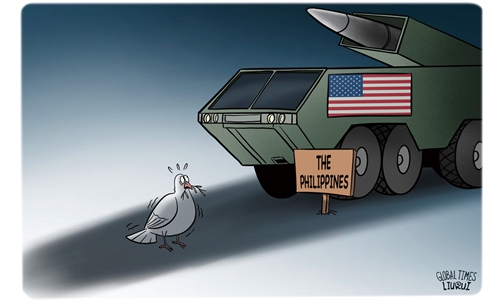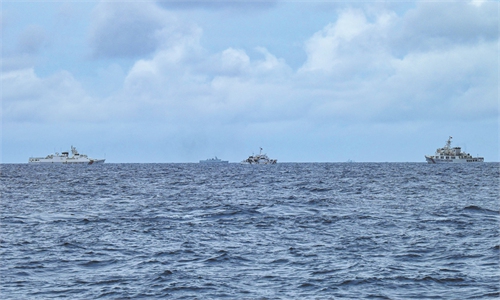
Photo: GT
Editor's Note:
The year 2024 witnessed regional turmoil and profound landscape changes. From the Russia-Ukraine conflict to the chaos in the Middle East and the interference of external forces stirring tensions in the South China Sea, China has demonstrated composure and confidence amid a turbulent landscape, creating a favorable external environment for its high-quality development and injecting valuable stability into a restless world. As a member of the Global South, China is playing an increasingly important role in promoting world development and peace, as well as advancing the rise of the Global South. As 2024 ended, the Global Times (GT) runs a special year-ender series by talking to renowned experts and former diplomats to discuss China's role and the scenes that shaped the global landscape in the past year.
In the final piece of this series, GT reporter Wang Wenwen interviewed Kin Phea (Kin), director general of the International Relations Institute of the Royal Academy of Cambodia, over the South China Sea situation. He believes that China's approach to handling the South China Sea demonstrates its wider approach of prioritizing dialogue and multilateral mechanisms and highlights its inclination toward a practical and regulated strategy for maintaining peace while protecting its maritime interests.
GT: Looking back at the situation in the South China Sea in 2024, the region generally remained peaceful, despite the fact that, from early last year, the Philippines continuously provoked China over the South China Sea issue. How do you evaluate China's response to these provocations and its approach to handling the South China Sea disputes?
Kin: China's response to the Philippine provocations in the South China Sea in 2024 was primarily calculated and strategic, focused on preserving regional stability while insisting on its territorial claims. In spite of the Philippines' aggressive measures, including enhancing maritime patrols and conducting joint military exercises with the US, China has refrained from direct escalation. Instead, it has utilized a mix of diplomatic interactions, economic benefits and restricted military actions to establish its presence. China has upheld a strong position without using aggressive methods that might disrupt regional stability.
Additionally, China's strategy demonstrates its wider approach of prioritizing dialogue and multilateral mechanisms, illustrated by its backing of the current discussions on the Code of Conduct (COC) in the South China Sea with ASEAN nations.
This illustrates Beijing's aim to resolve conflicts within a regional context instead of relying on outside involvement. China's caution is driven by its aim to enhance its global reputation, particularly in line with the tenets presented in its Global Development Initiative (GDI) and Global Security Initiative (GSI). In general, China's measured reaction highlights its inclination toward a practical and regulated strategy for maintaining peace while protecting its maritime interests.
GT: The US stepped up its efforts to "support" the Philippines, including the deployment of the Typhon missile system. In your opinion, what is behind the US "support" of the Philippines in the South China Sea issue?
Kin: The US bolstering its support for the Philippines in 2024 signifies its broader strategy to counteract China's influence in the so-called Indo-Pacific region. This "support" arises from multiple factors. Initially, the Philippines' important position along vital maritime routes establishes it as a crucial partner in maintaining what the US calls navigation freedom in the South China Sea. Second, by strengthening the military capabilities of the Philippines, the US aims to reassure allies like Japan and Australia of its determination to maintain security commitments amid China's rising power.
Ultimately, backing the Philippines is in line with Washington's "Indo-Pacific Strategy," which focuses on forming coalitions to challenge China's increasing influence.
GT: Why do you think the US and the Philippines fail to woo other ASEAN countries against China?
Kin: The US and the Philippines have faced challenges in uniting ASEAN nations against China because of the region's varying interests and its inclination toward neutrality. The core principle of consensus within ASEAN complicates the establishment of a unified position on the South China Sea, particularly as member nations maintain differing ties with Beijing. For example, nations such as Cambodia and Laos maintain strong economic and political ties with China while the US overlooks these two nations.
Additionally, ASEAN countries prioritize economic stability and growth, sectors where China's Belt and Road Initiative and various investments have a substantial impact. Moreover, ASEAN nations are cautious about being entangled in the rivalry between the US and China. They choose to maintain relationships with both sides instead of aligning with one against the other.
The US and the Philippines are also confronting credibility challenges. ASEAN countries doubt the US' enduring dedication to the area, considering its past tendency of erratic involvement. Consequently, ASEAN nations focus on their diplomatic efforts, like the COC, rather than succumbing to external demands to unite against China.
GT: In 2024, China continued to promote the implementation of the GDI, the GSI and the Global Civilization Initiative (GCI). In your opinion, what kind of Chinese wisdom do these three initiatives contribute to peace in the South China Sea?
Kin: The GDI highlights the importance of inclusive growth and interconnectivity, promoting regional collaboration that goes beyond conflicts. Through providing economic incentives and infrastructure initiatives, China has cultivated goodwill within ASEAN nations, establishing a setting favorable for dialogue.
The GSI promotes comprehensive and cooperative security, supporting non-interference and the peaceful settlement of disputes. This is consistent with China's backing of the ASEAN-driven COC talks, which seek to create a rules-based mechanism for addressing conflicts in the South China Sea. China's restraint in response to provocations further shows its dedication to the GSI's values of mutual respect and conflict prevention.
The GCI prioritizes mutual understanding and cultural exchange, highlighting collective heritage and shared objectives.
Collectively, these efforts embody a wider vision of peaceful coexistence, enhancing stability in one of the globe's most disputed areas.
GT: How do you predict the South China Sea situation in 2025?
Kin: The South China Sea will continue to be a possible source of tensions for China-US relations in 2025, due to the region's strategic and symbolic significance for both nations. For the US, upholding "freedom of navigation" and backing allies such as the Philippines are key components of its "Indo-Pacific" approach.
For China, claiming sovereignty over the South China Sea is a fundamental national interest. The likelihood of misjudgment is elevated due to the rising activities of military operations and interactions in contentious waters.
To prevent conflict, all parties should focus on communication and trust-building initiatives. Instruments like the ASEAN-led COC and bilateral pacts on engagement rules can aid in minimizing the likelihood of unintended confrontations.
A wider focus on economic collaboration and common goals in fields such as climate change and regional growth may also reduce tensions. In the end, steering clear of a flashpoint will necessitate moderation and a dedication to resolving conflicts through diplomatic efforts rather than military approaches, ensuring that the South China Sea remains a zone of peace and cooperation.



